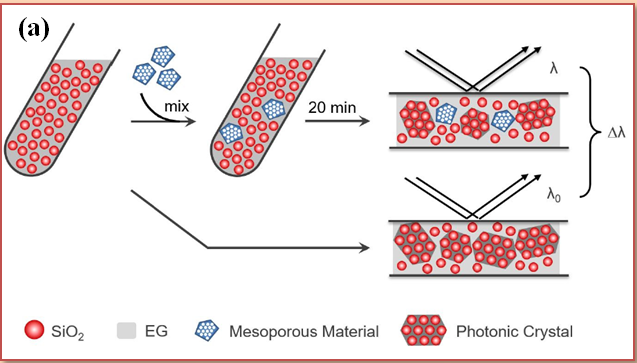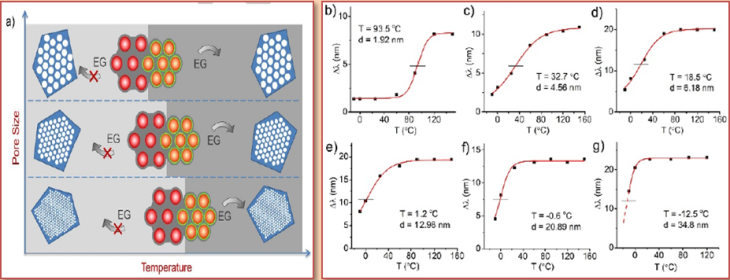Determination of pore characteristics of porous materials are very vital for their practical application in drug delivery, oil-water separation, etc. Isothermal adsorption and desorption of N2, a method commonly employed for the measurement of mesopore volume, pore diameter and surface area, is time-consuming besides involving the use of expensive instrument and consumption of liquid N2. Researchers at School of Chemistry and Molecular Engineering, Shanghai Key Laboratory of Green Chemistry and Chemical Processes, East China Normal University, China, have developed a novel method to measure pore characteristics of mesoporous materials by mixing them with supersaturated SiO2 colloidal solution at different temperatures, followed by quick measurement of “absorption induced reflection wavelength changes” of the precipitated liquid photonic crystals (PC). The positive relationship between pore volume (V) and unit mass reflection wavelength change (Δλ/m), and the negative relationship between pore diameter (D) and average absorption temperature (T) are used to determine the pore volume and pore diameter.
Supersaturated solution of SiO2 particles in various organic solvents spontaneously precipitate to form liquid PCs in which the particle size controls their structural colors and reflection peaks. A supersaturated ethylene glycol-ethanol (EG-EtOH) solution of SiO2 particles can be used as a “mesopore indicator” and when it is mixed with mesoporous materials, part of the solvent will be irreversibly absorbed into the mesopores, which increases the volume fraction of SiO2 particles in solution, shrinks the lattice constant of precipitated PCs and monotonically decreases the reflection wavelength.
The “absorption induced reflection blueshift” is schematically illustrated in Fig. 1(a). A supersaturated SiO2/EG-EtOH solution is placed for several minutes to precipitate red PCs. When pieces of porous silica are carefully spread into the solution (Fig. 1(b)), the red PCs around the porous powders turns green immediately (Fig. 1(c)). The microscopic reflection exhibits a blue shift of 56 nm (from 553 to 609), which indicates shrinkage of lattice constant of PCs that occurs along with solvent transfer to porous substance (Fig. 1(d)).

 Fig. 1 (a) Schematic illustration of the measurement of reflection wavelength change of PCs; (b) dried porous silica powders added to the supersaturated SiO2/EG-EtOH solution; (c) precipitated red photonic crystals turned green around the porous powder; and (d) reflection spectra of colloidal PCs
Fig. 1 (a) Schematic illustration of the measurement of reflection wavelength change of PCs; (b) dried porous silica powders added to the supersaturated SiO2/EG-EtOH solution; (c) precipitated red photonic crystals turned green around the porous powder; and (d) reflection spectra of colloidal PCs
The pore volume (V) has a positive relationship with the reflection wavelength changes induced by unit mass of porous materials (Δλ/m), which is schematically represented in Fig. 2(a). For mesoporous silica standards, an increase in mesopore mass (m), increases the wavelength change (Δλ) following the “absorption induced reflection blueshift”, which is also reflected by an increase in slope of the “Δλ-m” curve (Figs. 2(b) and 2(c)). A measure of the reflection wavelength change actually is a precise indicator of the amount of absorbed solvent as well as the pore volume (V).
 Fig. 2 (a) Schematic representation of the positive relationship between pore volume (V) and the reflection wavelength changes induced by unit mass of porous materials (Δλ/m); (b) increase in wavelength change (Δλ) and an increase in slope of the “Δλ-m” curve with an increase in mesopore mass (m)
Fig. 2 (a) Schematic representation of the positive relationship between pore volume (V) and the reflection wavelength changes induced by unit mass of porous materials (Δλ/m); (b) increase in wavelength change (Δλ) and an increase in slope of the “Δλ-m” curve with an increase in mesopore mass (m)
The pore diameter (D) has a negative relationship with the average absorption temperature (T) of mesopores, which is schematically represented in Fig. 3(a). When the SiO2/EG-EtOH solution is mixed with a silica standard with a pore diameter of 1.92 nm, the reflection change of liquid PC (Δλ) is close to zero at low temperature. An increase in temperature from 60 ℃ to 120 ℃ increases the thermal motion and the kinetic energy of the solvent molecules and promotes absorption of solvent into the mesopores, resulting in a gradual increase in Δλ. At temperatures >120 ℃, Δλ reaches a maximum value following a saturation in the absorption of solvent molecules. Simulation of Δλ vs. T curve using Boltzmann function indicates a negative correlation between the average absorption temperature (T) and the pore diameter (D). Accordingly, T is decreased from 93.5℃, to -12.5℃ for mesopore silica standards with D ranging from 1.92 nm to 34.8 nm (Fig. 3(b)-3(g)). It is evident that larger mesopores are easily filled at low temperatures while the smaller pores are filled only at high temperature. The negative correlation between T and D can be used to determine the pore size.
 Fig. 3 Schematic representation of negative relationship of pore diameter (D) with average absorption temperature (T) of mesopores SiO2; (b-g) temperature evolution of reflection change caused by the addition of mesoporous silica standards with different pore volumes
Fig. 3 Schematic representation of negative relationship of pore diameter (D) with average absorption temperature (T) of mesopores SiO2; (b-g) temperature evolution of reflection change caused by the addition of mesoporous silica standards with different pore volumes
The methodology is validated by testing two well-known mesoporous silica, viz., MCM41 and SBA15. The pore volumes and pore diameters estimated by N2 adsorption-desorption isotherms and BJH pore distributions are 0.898 cm3/g and 2.43 nm for MCM41, and 0.96 cm3/g and 8.04 nm for SBA15. The average absorption temperature measured using the reflection change of the PCs for MCM41 and SBA15 are 88.1°C and 8.5°C, which indicates their pore diameters are 2.33 nm and 10.86 nm. The mass evolution of reflection change shows that the Δλ/m for MCM41 and SBA15 are 2.49 nm/mg and 2.56 nm/mg, which indicate that their pore volumes are about 0.955 cm3/g and 1.00 cm3/g. The pore characteristics of MCM41 and SBA15 measured by N2 adsorption-desorption and based on the “absorption induced reflection wavelength changes” of PCs are close, suggesting the suitability of the later method as an alternative for the N2 adsorption-desorption method.
The method based on the measurement of “absorption induced reflection wavelength changes” of the precipitated liquid PC provides a convenient, efficient way to characterize mesoporous materials. This methodology could also be explored for non-silica based porous materials with suitable modification for wettability.
T.S.N. Sankara Narayanan
For more information, the reader may kindly refer: Biting Zhu et al., Liquid Photonic Crystals for Mesopore Detection, Angew. Chem. Int. Ed. 10.1002/anie.201710456
Advertisements Share this:- More





